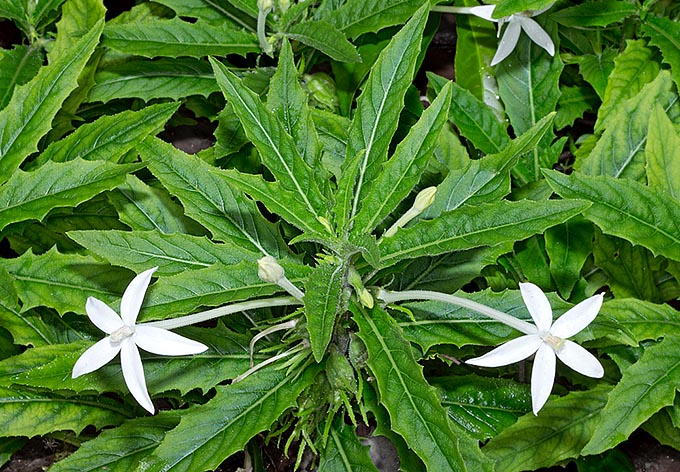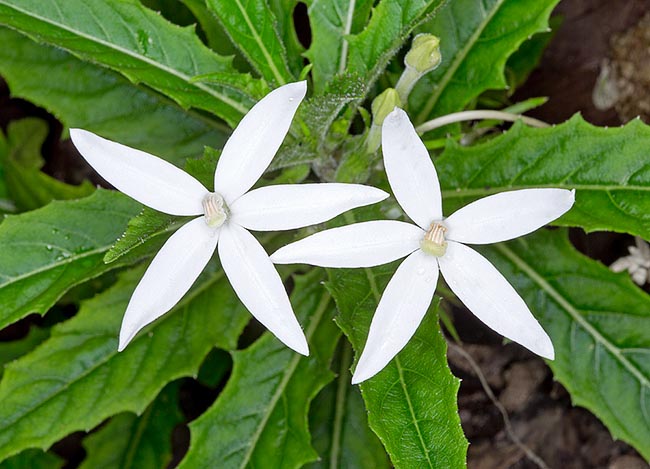Family : Campanulaceae

Text © Pietro Puccio

English translation by Mario Beltramini

Native to Jamaica, Hippobroma longiflora has naturalized in the tropics as ornamental plant © Giuseppe Mazza
The generic name, as specified by the author, George Don (1798-1856), is the combination of the Greek substantives “ἵππος” (ippos) and “βρομος” (bromos) poison, with reference to the high toxicity of the plant, the specific name is the combination of the Latin adjective “longus, a, um” = long and of the substantive “flos, -oris” = flower, with obvious reference.
Common names: frog’s flower, horse poison, madam fate, star-of-Bethlehem (English); ma zui cao (Chinese); etoile de Bethléem, herbe-poison, lastron blanc (French); arrebenta boi, arrebenta cavallos, cega-olho, jasmin de cachorro, jasmin de Italia (Portuguese-Brazil); flor de San Juan, flor de sapo, lágrimas de María, lágrimas de San Diego, revienta cavallo, tibey, tibey blanco (Spanish); Stern von Bethlehem (German).
The Hippobroma longiflora (L.) G.Don (1834) is a perennial herbaceous species with erect or at times decumbent stem, little ramified, 20-60 cm tall, with whitish fleshy roots and milky sap, with quite unpleasant smell. The leaves are simple, alternate, subsessile, elliptic to obovate-lanceolate with irregularly toothed margins and pointed apex, 5-15 cm long and 1-3,5 cm broad, almost glabrous above, slightly villous below, with prominent nervations. The flowers, at the axil of the upper leaves on a 1,5 cm long peduncle, are solitary, erect, perfumed, with penta-parted calyx with ciliate and indented segments, 0,8-2 cm long, of green colour, hypocrateriform white corolla (with extended lobes perpendicular to a long thin tube) with cylindrical tube, 6-12 cm long and of 0,4 cm of diameter, villous, and 5 elliptic to lanceolate lobes with pointed apex, 1,5-2,5 cm long and 0,5 cm broad, staminal tube that juts about 0,5 cm out from the corolla.

Unluckily it's highly poisonus, even to the touch, and can become invasive © Giuseppe Mazza
Very ornamental species thanks to the white scented flowers, but amongst the most poisonous, to be handled with extreme caution due to the presence in its sap of substances highly irritant for contact with immediate effects, in the eyes may cause blindness and on the skin serious allergic reactions, fatal cases are reported due to prolonged contact; the use of gloves is therefore indispen- sable when handling it. If ingested is highly poisonus because of the presence of cardioactive alkaloids, such as the lobelanidine, that may quickly lead to death. Rarely utilized in minimal doses in the traditional medicine, with effects that, in some cases, have been fatal.
It grows in the tropical and humid subtropical climate zones, where has naturalized escaping the cultivation and becoming in some cases invasive, in full sun as well as partially shaded and is not particular about the soil, even if poor.
It is reported here only to facilitate its identification, its cultivation is strongly discouraged due to its invasiveness and, especially, its high toxicity.
Synonyms: Lobelia longiflora L. (1753); Rapuntium longiflorum (L.) Mill. (1768); Isotoma longiflora (L.) C.Presl (1836); Laurentia longiflora (L.) Peterm. (1845); Isotoma runcinata Hassk. (1859); Laurentia longiflora var. runcinata (Hassk.) E.Wimm. (1948); Isotoma longiflora var. runcinata (Hassk.) Panigrahi, P.Daniel & M.V.Viswan. (1981); Solenopsis longiflora (L.) M.R.Almeida (2001).
